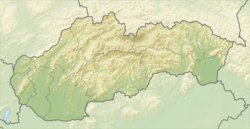Baloň
|
Baloň Balony |
|
|---|---|
| village | |
| Location of the village | |
| Coordinates: 47°50′00″N 17°40′00″E / 47.83333°N 17.66667°ECoordinates: 47°50′00″N 17°40′00″E / 47.83333°N 17.66667°E | |
| Country |
|
| Region | Trnava |
| District | Dunajská Streda |
| First written mention | 1252 |
| Government | |
| • Mayor | Frigyes Matus (Party of the Hungarian Coalition) |
| Area | |
| • Total | 16.07 km2 (6.20 sq mi) |
| Elevation | 111 m (364 ft) |
| Population (2001) | |
| • Total | 735 |
| • Estimate (2008) | 756 |
| • Density | 47/km2 (120/sq mi) |
| Ethnicity | |
| • Hungarians | 94,01% |
| • Slovakians | 5,31% |
| Time zone | EET (UTC+1) |
| • Summer (DST) | EEST (UTC+2) |
| Postal Code | 930 08 |
| Area code(s) | +421 31 |
Baloň (Hungarian: Balony, Hungarian pronunciation:[ˈbɒloɲ]) is a village and municipality in the Dunajská Streda District in the Trnava Region of south-west Slovakia.
The municipality lies at an altitude of 111 metres (364 ft) and covers an area of 16.073 km2 (6.206 sq mi). It has a population of about 756 people.
In the late of 9th century, the territory of Baloň became part of the Kingdom of Hungary. In historical records the village was first mentioned in 1252. It was part of Győr County. After the Austro-Hungarian army disintegrated in November 1918, Czechoslovak troops occupied the area, later acknowledged internationally by the Treaty of Trianon. Between 1938 and 1945 Baloň once more became part of Miklós Horthy's Hungary through the First Vienna Award. From 1945 until the Velvet Divorce, it was part of Czechoslovakia. Since then it has been part of Slovakia.
The records for genealogical research are available at the state archive "Statny Archiv in Bratislava, Slovakia"
...
Wikipedia

